
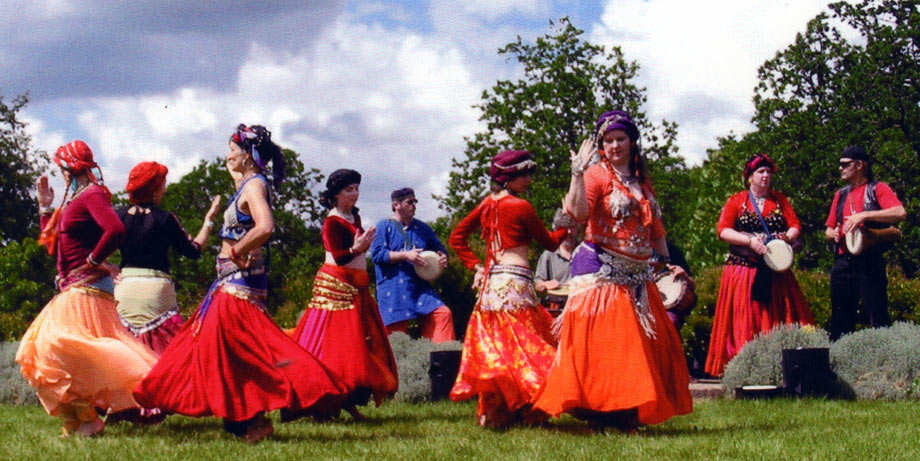
The Sacred Feminine in Tantra and Belly Dancing
by Barbara Beausoleil
An excerpt from FEMININE MYSTICISM IN ART: ARTISTS ENVISIONING THE DIVINE - Edited by Victoria Christian and Susan Stedman
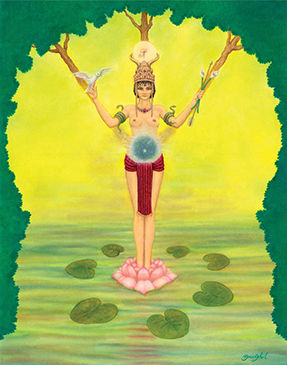
Nothing is more erotic, dramatic and sensual than the Yoga tradition of Tantra from India, a part of the Shakta tradition that is devoted to the Goddess in all her forms. For Westerners starved of images of the Goddess, Tantra has been a tool that helps people reclaim worship of the Goddess through its understanding of ritual, meditation and iconography. As we become more of a global community in the third millennium, the influence of the Hindu tradition is beginning to have an enormous influence on the larger awakening of the Goddess in the West, bringing us that much closer to a partnership model of equality between the sexes.
Tantra is a living expression of divinity. It is not static. Rather, it is a constantly evolving expression of our connection to Source. In Sanskrit the word TAN-TRA means to expand and to liberate. The body of Tantric literature and sacred texts (Tantras) that evolved over the centuries started during the early Christian era and continued through the eleventh century A.D. However, the origin of Tantric symbols is far older, dating back to 20,000 B.C. The influence of Tantra Yoga reached beyond the Indus Valley where its practice flourished around 3,000 B.C. Ancient Hindu, Buddhist and Jain literature contain references to Tantra, but the actual practice of Tantra is much older than any written text, and its influence can be seen in much of Asia as well as the ancient Mediterranean cultures of Crete and Egypt.
The final aim of Hindu Tantra is the realization of Cosmic Unity, which exists in the Supreme Being called Ishvara. Ishvara is the One spoken of as an Absolute Being, without qualities; unknowable and indescribable, without beginning and without end. Tantra recognizes that we exist in a world of dulities. Its goal is to use the power of dualities to achieve oneness. The two main forces at work in this duality are represented by the God Shiva and his female counterpart, the God Shakti. Tantra is the practice of uniting the male and female principles in a sacred marriage of Shakti/Shiva. In Tantra, the human body is a microcosm of the Universe. All that exists in the human mind and body exists in the Cosmic Mind and Body, and vice versa. During Tantric rituals, the man becomes the male deity Shiva, and the female embodies the Goddess Shakti. An image by Paul Heusstenstamm titled, Shakti/Shiva illustrates this union beautifully.
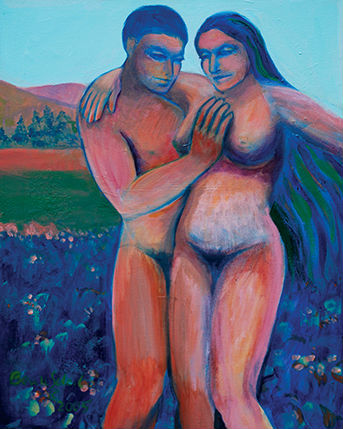 A Tantrika (one who practices Tantra) uses certain practices to arouse all the physical, emotional and mental energies within, and focuses those energies on the experience of the Oneness of Creation. For most Tantrikas, Shakti, whose name means Power, most directly accesses the activity of creation, and offers the most direct approach to an ecstatic connection to Source. The masculine image of Shiva is felt to be more remote and less accessible, so most Tantric rituals are addressed to the Goddess Shakti. She represents spiritual power, luminous consciousness, the divine eternal Female, Mother of the World. Tantrikas perform pujas, combining rituals and meditations, to align themselves with Shakti. Many female icons are used in Tantric rituals, such as lotus flowers, downward pointing triangles, caves, clefts and hollows in trees and rocks, coco-de-mer, and the female vulva. Because of the emphasis on the female aspect of Creator, women play a very important role in Tantric practice. They are the carriers of Shakti energy. It is only by harmonious interaction with women that a male Tantrika can progress along the Tantric path. All acts of love are experienced as microcosms of the cosmic act, and the more completely it is expressed, the closer it is to the divine expression. Woman and man must continually stimulate and fulfill each other. Only after long practice together can either complete a Tantric ritual alone. One form of expression of the Cosmic Union is through sex, another is through dance. Tantric deities are often depicted dancing. One metaphor for the most remote creative sound in the Universe is the tinkling anklet of the female dancer, whose dancing weaves the visible pattern of the world. Shiva is known as Lord of the Dance.
A Tantrika (one who practices Tantra) uses certain practices to arouse all the physical, emotional and mental energies within, and focuses those energies on the experience of the Oneness of Creation. For most Tantrikas, Shakti, whose name means Power, most directly accesses the activity of creation, and offers the most direct approach to an ecstatic connection to Source. The masculine image of Shiva is felt to be more remote and less accessible, so most Tantric rituals are addressed to the Goddess Shakti. She represents spiritual power, luminous consciousness, the divine eternal Female, Mother of the World. Tantrikas perform pujas, combining rituals and meditations, to align themselves with Shakti. Many female icons are used in Tantric rituals, such as lotus flowers, downward pointing triangles, caves, clefts and hollows in trees and rocks, coco-de-mer, and the female vulva. Because of the emphasis on the female aspect of Creator, women play a very important role in Tantric practice. They are the carriers of Shakti energy. It is only by harmonious interaction with women that a male Tantrika can progress along the Tantric path. All acts of love are experienced as microcosms of the cosmic act, and the more completely it is expressed, the closer it is to the divine expression. Woman and man must continually stimulate and fulfill each other. Only after long practice together can either complete a Tantric ritual alone. One form of expression of the Cosmic Union is through sex, another is through dance. Tantric deities are often depicted dancing. One metaphor for the most remote creative sound in the Universe is the tinkling anklet of the female dancer, whose dancing weaves the visible pattern of the world. Shiva is known as Lord of the Dance.
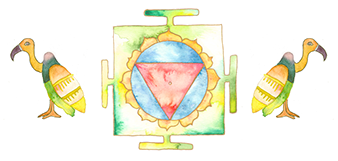
Belly Dancing as an Invocation of Shakti
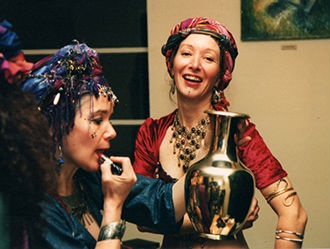 When I started my dance troupe, Raks Sarama, in 2002, I had been a student of Tantra for many years. I had also been doing tribal style Middle Eastern dance for over a decade. The two blended well together, as if they were soul partners. The undulating movements of what most of us know as belly-dancing are sensual and life-affirming. In tribal style dance, we rarely dance alone. I describe what we do to be a cross between belly-dance and folk dance. We dance in a group, sometimes with a dozen or more dancers moving in unison, creating waves in the space that surrounds us. It is like making love to the air. In our finest moments, the dance becomes a prayer, an invocation of Shakti. For me, this dance is the embodiment of female power and feminine mysticism. All bodily movement generates air currents, waves of air that undulate outward into the Universe. When many dancers move in unison, the wave that is created is larger and moves farther. I have even seen balls of light generated by a group of dancers; such is the ability of the group to focus their energy.
When I started my dance troupe, Raks Sarama, in 2002, I had been a student of Tantra for many years. I had also been doing tribal style Middle Eastern dance for over a decade. The two blended well together, as if they were soul partners. The undulating movements of what most of us know as belly-dancing are sensual and life-affirming. In tribal style dance, we rarely dance alone. I describe what we do to be a cross between belly-dance and folk dance. We dance in a group, sometimes with a dozen or more dancers moving in unison, creating waves in the space that surrounds us. It is like making love to the air. In our finest moments, the dance becomes a prayer, an invocation of Shakti. For me, this dance is the embodiment of female power and feminine mysticism. All bodily movement generates air currents, waves of air that undulate outward into the Universe. When many dancers move in unison, the wave that is created is larger and moves farther. I have even seen balls of light generated by a group of dancers; such is the ability of the group to focus their energy.
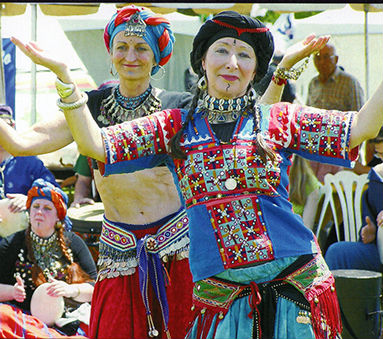 Some people call us belly-dancers, but this is a deceptive term, one that brings to mind a scantily clad woman shimmying and gyrating across the floor. Our dances are based on Middle Eastern movements and rhythms, but we draw from many other disciplines as well, from ballet and flamenco, to Native American and Polynesian. We are fusion folk dancers. We dance at festivals and fairs, weddings, parties and proms. We dance for the sheer joy of it, for the pleasure of moving our bodies through the air to the rhythm of the drums, and because it is a sacred Tantric ritual, one that joins us at the hip and the heart. We begin our ritual with a hot bath, preferably in a deep claw-foot tub. After the bath, the dancer starts assembling the multiple layers of her costume. We start with harem pants. Since these are closest to the skin, the kind of fabric they are made of is very important. It must be soft and fairly light, not too heavy, stiff or scratchy. It must feel good against your skin. I prefer cotton or silk. The color will depend on the rest of the costume. I have a dozen pairs of harem pants to choose from, in a myriad of colors. Getting dressed is like turning yourself into a piece of art-- a colorful sculpture that moves. A full circle kirt goes over the harem pants. The fabric must have some weight to it so that it flares out as the dancer spins, exposing the billowing harem pants beneath.
Some people call us belly-dancers, but this is a deceptive term, one that brings to mind a scantily clad woman shimmying and gyrating across the floor. Our dances are based on Middle Eastern movements and rhythms, but we draw from many other disciplines as well, from ballet and flamenco, to Native American and Polynesian. We are fusion folk dancers. We dance at festivals and fairs, weddings, parties and proms. We dance for the sheer joy of it, for the pleasure of moving our bodies through the air to the rhythm of the drums, and because it is a sacred Tantric ritual, one that joins us at the hip and the heart. We begin our ritual with a hot bath, preferably in a deep claw-foot tub. After the bath, the dancer starts assembling the multiple layers of her costume. We start with harem pants. Since these are closest to the skin, the kind of fabric they are made of is very important. It must be soft and fairly light, not too heavy, stiff or scratchy. It must feel good against your skin. I prefer cotton or silk. The color will depend on the rest of the costume. I have a dozen pairs of harem pants to choose from, in a myriad of colors. Getting dressed is like turning yourself into a piece of art-- a colorful sculpture that moves. A full circle kirt goes over the harem pants. The fabric must have some weight to it so that it flares out as the dancer spins, exposing the billowing harem pants beneath.
Some dancers expose their bellies and some do not. The choice of what will be worn on top depends on what each dancer feels comfortable wearing. We often wear Indian cholis that are heavily embroidered and covered in tiny flashing mirrors that catch the light and sparkle when we dance. Sometimes we wear halter-tops and bras covered with antique coins and shells. Then we move down to the hips. Often a triangle scarf is the first layer, or a triangle shaped tassel belt. In Tantra, this downward pointing triangle is recognized as a symbol of the Goddess, as in the Kali Yantra. Over the hip scarf or tassel belt we wear coin belts or kuchi medallion belts from the tribal regions of Pakistan. The hips are where you want the most jingling, so lots of coins and bells are worn there. The face of the Goddess is not to be outdone by garments, however. We emphasize our eyes with a dark kohl outline and often embellish our faces with tattoo designs. A decorative bindi dot is placed at the third eye. The final crowning touch is the turban. We always wear turbans for performances. It gives the troupe a unified, dignified look and is another place to hang jewelry and embellishments. We wear large cuff bracelets and bangles, chokers and necklaces, earrings and ankle bells. By the time we are finished dressing, the transformation is complete. Each dancer has become a manifestation of the Goddess.
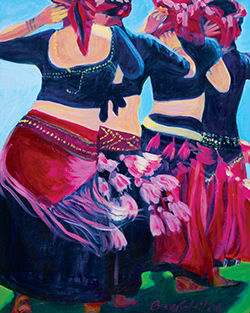 As with all dance disciplines, practice is key. It takes many hours of practice to master a single movement, and many more to memorize choreography. When I say “memorize” I’m not talking about mental activity. I’m talking about the state of consciousness that thrusts you out of your head and into your body. It is the intelligence or wisdom of the body, otherwise referred to as muscle-memory. It’s what happens when we no longer have to think about what comes next; our bodies just know what to do. It is at this point of mastery that the dance is transformed into sacred ritual. The dancers become physical manifestations of the goddess Shakti, a catalyst that sends energy up through the chakras. We exude goddess-energy. The ability to isolate and move different parts of the body is essential to this dance. Our movement begins at the heart chakra, responding to the beat of the drums. We lift our rib cages as if there are golden cords attached to our solar plexi, lifting us up and forward. Our hearts open and the lungs expand. Then we release. Torsos continue to lift and release, creating a wave of energy. This is the movement many dancers know as the “camel.” We move forward in a line, undulating our way across the floor. On a verbal signal, a dancer’s torso becomes stationary, and the hips and pelvis begin moving in slow circles that turn into twisting figure 8s as the arms rise to the heavens like grasses waving in the wind.
As with all dance disciplines, practice is key. It takes many hours of practice to master a single movement, and many more to memorize choreography. When I say “memorize” I’m not talking about mental activity. I’m talking about the state of consciousness that thrusts you out of your head and into your body. It is the intelligence or wisdom of the body, otherwise referred to as muscle-memory. It’s what happens when we no longer have to think about what comes next; our bodies just know what to do. It is at this point of mastery that the dance is transformed into sacred ritual. The dancers become physical manifestations of the goddess Shakti, a catalyst that sends energy up through the chakras. We exude goddess-energy. The ability to isolate and move different parts of the body is essential to this dance. Our movement begins at the heart chakra, responding to the beat of the drums. We lift our rib cages as if there are golden cords attached to our solar plexi, lifting us up and forward. Our hearts open and the lungs expand. Then we release. Torsos continue to lift and release, creating a wave of energy. This is the movement many dancers know as the “camel.” We move forward in a line, undulating our way across the floor. On a verbal signal, a dancer’s torso becomes stationary, and the hips and pelvis begin moving in slow circles that turn into twisting figure 8s as the arms rise to the heavens like grasses waving in the wind.
There is a sense of vitality and nourishment that comes from dancing. The more you allow your body to dance, the more it loves you. The movements provide an internal massage for all your glands and organs. They stretch and strengthen muscles, keep the blood circulating throughout your body and are a source of grounding. They let your body know it’s good to be alive. We may enter the studio feeling tired after a long day, but when we leave after a night of dancing, we are revitalized (and often ravenously hungry!) Pasha, one of our drummers, says that the dance has brought new passion and vitality to his relationship with his wife. Those of us with partners know this to be true. A woman’s body becomes enlivened when she dances. As the oxygenated blood in the body circulates, it activates all the cells in the body. Some of the movements of the dance, particularly those involving the hips and pelvis, are much like the movements of sex. Once the juices start flowing, it is a natural progression
from dancing and drumming to lovemaking.
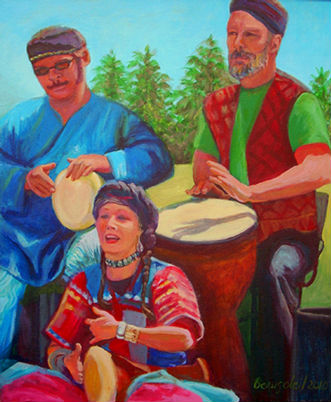 All of our drummers are married to dancers in our troupe. As representatives of the God Shiva, they are an essential part of our ritual. Their drums initiate the dance. They control the rhythm and tempo. Our drummers have a large repertoire of rhythms to draw on, from a slow, sultry chiftatelli to a rousing, heart-pounding ayoob. Although the drummers play a supportive role in the dance, their creativity comes through in their style of playing, adding trills and slaps and pauses to the sounds of their drums, and they often develop their own rhythms and variations of traditional rhythms. When the energy level of the drummers and dancers is high, we become Shiva and Shakti engaging in the dance of life. The combination of music and movement blends together in a seamless creation. All participants are transported into a trance-like state that brings us into the moment, as our sense of time dissipates.
All of our drummers are married to dancers in our troupe. As representatives of the God Shiva, they are an essential part of our ritual. Their drums initiate the dance. They control the rhythm and tempo. Our drummers have a large repertoire of rhythms to draw on, from a slow, sultry chiftatelli to a rousing, heart-pounding ayoob. Although the drummers play a supportive role in the dance, their creativity comes through in their style of playing, adding trills and slaps and pauses to the sounds of their drums, and they often develop their own rhythms and variations of traditional rhythms. When the energy level of the drummers and dancers is high, we become Shiva and Shakti engaging in the dance of life. The combination of music and movement blends together in a seamless creation. All participants are transported into a trance-like state that brings us into the moment, as our sense of time dissipates.
The drums begin and the dancers move out into the space provided. We love to dance outside because there is plenty of room to move. There are fourteen dancers in our troupe, and when we are all dancing at the same time, we take up quite a bit of space. Zaghreets trill out and people gather around to watch. The dancers begin to accompany the drums with their zills (finger cymbals) and the dance begins. Sparkling bodices, twirlingskirts, flashing harem pants, the sounds of drums and zills draw the audience into the sacred space. Spellbound, they become embraced in a Tantric ritual invoking the Goddess Shakti.
When we dance, we are practicing Tantra. We are sending an invocation to the universe as a way of honoring the sacred dance, this organization of cells called the dancers of Raks Sarama, to create movement within our own bodies. In using dance as a source of ritual, we are renewing, stimulating and aligning our minds, bodies, souls and hearts. Our organs, glands, muscles, skeletons, ligaments, tendons, are all moving synchronistically, emulating and bridging the polarities in our bodies and in the external world. We are moving and stretching, extending and contracting, stimulating blood flow; using our bodies as instruments to create art. As homage to Shakti, the source of female power, we dance to the heartbeat of the Earth, the rhythm of the drum, expressing our feminine wisdom that emerges from our bellies and hearts.
Copyright 2011 by Victoria Christian. All right reserved. No part of the book may be used or reproduced in any manner whatsoever without written permission except in the case of brief quotations embodied in critical articles and reviews. For information, please contact New Paradigm Publishing, www.victoriachristian.com.
The Goddess Astarte: Mother of Mothers
a painting by Bobby for Barbara
©2014 Beth Hall | Images are copyrighted to their respective owners
< BACK TO HOME